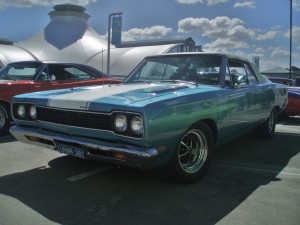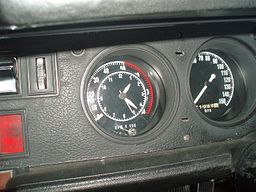The 1968 Plymouth Road Runner B-body muscle car offered budget-friendly performance, featuring a bare-bones design and powerful engines in Chrysler’s acclaimed first-generation platform – the Belvedere, which ran from 1967-1970.
1968 Plymouth Road Runner Specs
Originally published April 2016 | Updated October 2024
Image by sv1ambo (1968 Plymouth Road Runner convertible) [CC BY 2.0 via Wikimedia Commons
1968 Plymouth Road Runner Information
The 1968 Road Runner’s body design perfectly balanced Plymouth’s performance aspirations with visual muscle. While built on the modest Belvedere platform, its aggressive muscle car stance and clean lines created an unmistakable street presence. The low-slung profile was accentuated by slim B-pillars and frameless door glass, creating a sleek silhouette that looked fast even standing still.
’68 Road Runner Body Styles and Features:
- Early ’68: Two-door pillared coupe only
- Mid-year addition: Pillarless hardtop variant
- Hood design: Twin power bulges (non-functional)
- Optional flat-black hood treatment ($18)
- Decor Group trim package on hardtops
- Distinctive brushed stainless steel trunk panel
’68 Road Runner Distinctive Design Elements:
- Wide, aggressive stance
- Clean, uncluttered body lines
- Minimal chrome trim
- Performance-oriented grille design
- Subtle wheel arch flares
- Body-colored steel wheels with dog-dish hubcaps
’68 Road Runner Common Inspection Points:
- Traditional rust-prone areas on the ’68 Road Runner:
-
- Quarter panels
- Trunk floor
- Rocker panels
- Floor pans
- Critical structural areas on the ’68 Road Runner:
-
- Steering box mounting points
- Hood hinge mounts
- Rear window lower corners
- Extensive reproduction sheet metal available for the ’68 Road Runner
-
- ’68-specific hood details
- Some fitment modification required
The 1968 Road Runner showcased Plymouth’s fresh design direction with clean, purposeful styling. While built on modest Belvedere foundations, its slim B-pillars and frameless door glass created an upscale hardtop profile. The hood featured distinctive twin bulges – though not yet functional scoops – and could be optioned with an aggressive flat-black treatment between them, signaling the Road Runner’s street-performance intentions.
The earliest ’68 Road Runners were only offered as a 2-door B-pillared coupe, meaning there was a pillar positioned between the front and rear windows; but later in 1968, Plymouth started to offer a pillarless hardtop model.
1968 Road Runner Engine
The 1968 Road Runner offered two potent V8 powerplants. The standard engine was a 383 cubic-inch (6.3L) V8 producing 330 horsepower. For maximum performance, Plymouth offered the legendary 426 Hemi (7.0L) V8, rated at 425 horsepower. Both engines featured a cast-iron block and overhead valve design with two valves per cylinder.
383 V8 (Standard)
- Displacement: 383 cu in (6,276 cc)
- Horsepower: 330 bhp @ 5,200 rpm
- Block: Cast iron
- Bore x Stroke: 4.3 x 3.4 inches (108 x 86 mm)
- Compression: 10.0:1
- Valvetrain: OHV, 16 valves
- Main Bearings: 5
426 Hemi V8 (Optional)
- Displacement: 426 cu in (6,981 cc)
- Horsepower: 425 bhp @ 5,000 rpm
- Block: Cast iron
- Bore x Stroke: 4.3 x 3.8 inches (108 x 95 mm)
- Valvetrain: OHV, 16 valves
- Nickname: “Elephant Motor”
The 1968 Road Runner was offered with a 383 cubic inch displacement (CID) V-8 that had been enhanced with the addition of high-performance 440 Magnum/Super Commando cylinder heads; the one engine option offered on the 1968 Road Runner was the 426 Hemi.
1968 Plymouth Road Runner Transmission
The ’68 Road Runner offered two transmission choices, each carefully matched to its V8 powerplant. The standard four-speed manual featured engine-specific gearing, while the optional TorqueFlite automatic provided effortless cruising.
Standard 4-Speed Manual
- A-833 heavy-duty 4-speed transmission
- Floor-mounted shifter
- 383 V8 ratios: 2.65 (1st), 1.93 (2nd), 1.39 (3rd), 1.00 (4th)
- Hemi ratios: 2.44 (1st), 1.93 (2nd), 1.39 (3rd), 1.00 (4th)
- Heavy-duty 11-inch clutch
Optional TorqueFlite A727 Automatic Transmission
- Column-mounted shifter
- Three-speed design
- Reinforced for high-torque applications
- Compatible with bench seat configuration
- Torque converter stall ratio: 2.45:1
- Heavy-duty cooling package
The standard package’s transmission for the ’68 Road Runner was a manual four-speed, with different gear ratios for the 383 and the 426 Hemi, but the three-speed TorqueFlite A727 automatic was available as an option; note that the TorqueFlight was a column-shift unit to accommodate the bench seat.
Image by sv1ambo (1968 Plymouth Road Runner convertible) [CC BY 2.0 via Wikimedia Commons
The 1968 Road Runner as a Muscle Car
The 1968 Road Runner exemplified Plymouth’s “bang for your buck” approach to muscle car design. Stripped of luxury pretenses, this 3,475-pound B-body warrior carried only the essentials for high-performance street action. Basic rubber floor mats replaced carpeting, and a no-nonsense bench seat emphasized the car’s singular mission: raw speed and quarter-mile dominance.
’68 Road Runner Performance Specifications
The 1968 Road Runner’s performance credentials were anchored by two formidable V8 engine choices, each offering serious street capabilities.
The standard powerplant was no mere budget compromise – Plymouth equipped the 383 cubic-inch B-series big-block engine option with high-flow heads, an aggressive camshaft, and free-breathing dual exhaust manifolds borrowed from the Super Commando 440, resulting in 335 tire-shredding horsepower.
For those seeking the ultimate in muscle car supremacy, the optional 426 Hemi engine option delivered a factory-rated 425 horsepower, though many believed this figure to be deliberately understated. Both engines have stood the test of time, with the 383 remaining highly serviceable thanks to plentiful parts availability.
While original Hemi components have become coveted collectors’ items, both engines provide an excellent foundation for performance builds, whether pursuing period-correct “Day Two” modifications or modern restomod enhancements.
- 383 V8 Model Standard Engine:
-
- 0-60 mph: 7.1 seconds
- Quarter mile: 15.2 seconds @ 96 mph
- Top speed: 137 mph
- 426 Engine Size Hemi Model:
-
- 0-60 mph: 5.3 seconds
- Quarter mile: 13.5 seconds @ 105 mph
- Top speed: 140+ mph
Built in an era when performance trumped efficiency, the Road Runner’s thirsty V8s demanded premium fuel and returned a mere 10.2 mpg. But in the golden age of muscle cars, fuel economy was an afterthought – stoplight-to-stoplight acceleration was the only statistic that mattered.
1968 Road Runner Interior
The 1968 Road Runner’s cabin perfectly reflected Plymouth’s “maximum performance, minimum frills” philosophy. Embracing its budget-muscle identity, the interior was deliberately austere – you wouldn’t find bucket seats or a flashy center console here. Instead, you got sturdy Belvedere basic vinyl bench seats, wrapped in either all-vinyl or vinyl-cloth combination upholstery, provided no-nonsense accommodation for up to three occupants.
Available Interior Options:
- AM radio
- Factory air conditioning
- Automatic speed control (cruise)
- Small-diameter factory tachometer
- Optional headrests (became mandatory in ’69)
- Choice of vinyl or cloth-vinyl bench seating
Period owners often modified the factory setup, particularly the undersized tachometer. Many opted to mount larger aftermarket units on the steering column or dashboard for better visibility during performance driving. This modification trend continues among today’s Road Runner enthusiasts, who appreciate the interior’s clean slate for personalization while maintaining its purposeful muscle car character.
’68 Road Runner Chassis
The 1968 Road Runner rode on Plymouth’s proven B-body platform, but every car came equipped with upgraded heavy-duty suspension and brake components to handle its muscular powertrains.
1968 Plymouth Road Runner Chassis Specifications:
- Heavy-duty suspension standard
- Front suspension: Torsion bar design
- Rear suspension: Heavy-duty leaf springs
- Standard brakes: 11-inch drums all around
- Optional front disc brakes with power assist
- Heavy-duty shock absorbers
1968 Road Runner Wheel and Tire Options:
- Standard 383 setup:
-
- 14 x 5.5-inch steel wheels
- Stainless steel dog-dish hubcaps
- F70-14 performance tires
- 1968 Plymouth Road Runner Hemi package:
-
- Upgraded 15 x 6-inch steel wheels
- Enhanced tire package
- Heavy-duty wheel bearings
- 1968 Road Runner Optional Wheels:
-
- Chrome Magnum 500 road wheels (popular dealer option)
- Full wheel covers (now rare collector items)
- Period-correct F70-14 or F70-15 redline tires
1968 Plymouth Road Runner Production Figures
The 1968 Road Runner proved to be a significant success for Plymouth, with 44,599 units produced in its debut year. This represented about 5.6% of Plymouth’s total 1968 production of 790,239 vehicles – an impressive figure for a new performance model. The strong sales validated Plymouth’s strategy of offering an affordable muscle car stripped of luxury features but loaded with performance. The Road Runner’s success would influence muscle car marketing for years to come, demonstrating that budget-minded performance enthusiasts represented a viable market segment.
- Total 1968 Plymouth Production: 790,239
- Total 1968 Road Runner Production: 44,599
1968 Plymouth Road Runner Collector’s Information
The 1968 Plymouth Road Runner’s market value reflects its significance in muscle car history, with prices ranging from $30,000 for driver-quality 383 models to well over $100,000 for documented Hemi cars in pristine condition. While total production of 44,599 units of these iconic classic muscle cars means these aren’t particularly rare, finding unmodified examples with documented histories has become increasingly challenging.
Original Hemi cars command premium prices, but even well-preserved 383 models continue to appreciate as collectors recognize the ’68 Plymouth Road Runner’s importance as Plymouth’s first purpose-built budget muscle car. Factors most affecting value include:
- Original drivetrain presence
- Documentation and build records
- Level of restoration quality
- Original color combinations
- Options and equipment
- Production date (early vs. late ’68)
Plymouth’s marketing of these 2-door pillared coupes was as bold as the car itself. In a first for the automotive industry, they paid Warner Brothers $50,000 for the Road Runner cartoon character name and likeness, plus another $10,000 to develop the distinctive “beep-beep” horn sound. This playful branding belied the car’s serious performance credentials, creating an instant street legend that perfectly balanced affordability and raw power.
Join the conversation about classic cars by visiting my ClassicCarsOnline US Facebook page and share your thoughts on these iconic muscle cars.
By: Laure Justice


